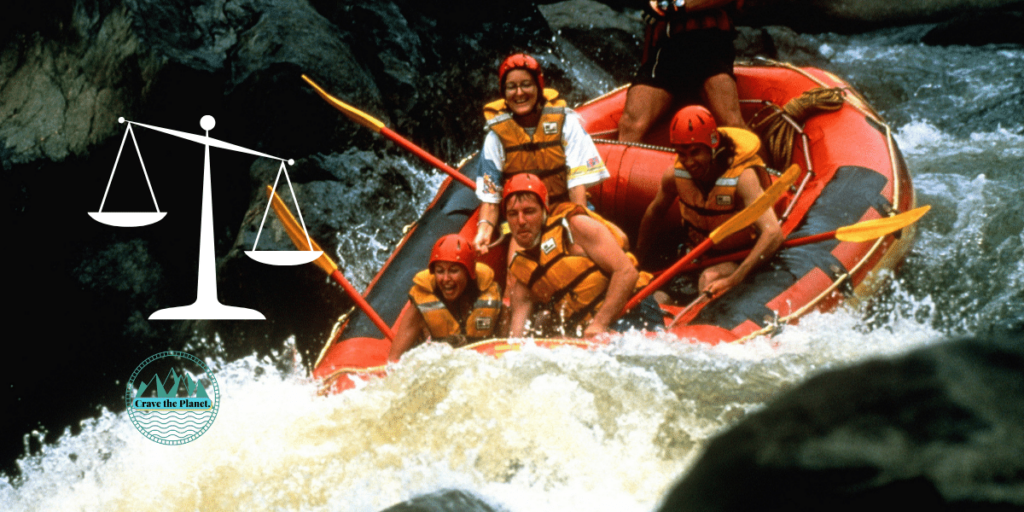Maybe you’re wondering: Is white water rafting dangerous? To all the other moms out there -Yes, it is. But so is walking across the street.
This article is not intended for compel you to go white water rafting. All activities are at your own risk. But I wanted to share some data and risk mitigation.
White water rafting is an exhilarating outdoor activity that has gained popularity among adventure seekers in recent years. This thrilling sport involves navigating through rapid water currents along rocky river channels, making it an exciting challenge for individuals and groups alike.
But as with any extreme sport, there are risks involved in white water rafting, and it’s essential to understand these dangers to ensure a safe and enjoyable experience.

Understanding the risks and dangers involved in white water rafting is crucial to make informed decisions about your upcoming adventure. Factors such as river conditions, weather, and the experience level of rafters contribute to the overall safety of the activity.
Choosing the right outfitter, ensuring proper safety equipment, and following safety precautions are all critical components that help minimize the risks and maximize the fun.
Key Takeaways: Is White Water Rafting Dangerous?
- White water rafting is thrilling but comes with inherent risks and dangers.
- Ensuring proper safety equipment and precautions keeps the experience enjoyable and secure.
- Choosing a reputable outfitter and following safety guidelines can help minimize potential hazards.
Understanding White Water Rafting
White water rafting is an exciting and challenging activity that offers adrenaline-pumping adventure for outdoor enthusiasts. It’s essential to understand the different types of rafts and river classifications to ensure your safety and enjoyment on the water. This section will provide you with a brief overview of the necessary information.
Types of Rafts
There are several types of rafts used in whitewater rafting, each offering unique advantages and challenges:
- Raft: A traditional raft is a large, inflatable boat designed to carry multiple people along with a guide. They provide stability and are often used for group trips and team-building experiences.
- Inflatable Kayak (IK): These smaller, one or two-person boats allow for more agility and control on the water. Though they require more physical effort, IKs offer a more intimate experience with the river.
- Canoe: Canoes are typically used by experienced paddlers looking for an even greater challenge. They’re less stable than other raft types and require advanced skills to navigate through whitewater.
Having a knowledgeable guide during your whitewater rafting adventure can greatly enhance the experience by sharing their expertise, helping with paddling techniques, and ensuring safety.
River Classifications
Rivers are classified according to their level of difficulty to help you determine the appropriate river for your skill level. Here’s a brief summary of the classifications:
- Class I: Easy – Small waves and clear passages make these rivers perfect for all ages and abilities. No guide is needed.
- Class II: Medium – Rapids are of low difficulty with clear passages. Suitable for everyone, no experience necessary. A guide is preferable but not required.
- Class III: Whitewater – These rivers have small waves and may require some maneuvering. Basic paddling skills are needed for these rapids.
As you venture into higher-class rivers, the difficulty increases, and having a skilled guide becomes increasingly essential. Remember, it’s crucial to respect the power of the river and be prepared for the challenges it presents. Always choose a whitewater rafting adventure that suits your skill level and experience.
Risks and Dangers Involved
Injuries and Fatalities
White water rafting, like many adventure sports, carries some risks and potential dangers. Although death is a major concern, it is relatively rare. Far more common are injuries sustained from collisions with rocks, boulders, and other river features. These injuries can happen even while you’re still inside the raft, as collisions with boulders can toss you around or even into the water.
Drowning is another risk, as is hypothermia, particularly in colder waters. Additionally, heart attacks can occur in those with pre-existing heart conditions due to the increased adrenaline and physical exertion. It’s crucial to not only know your own limitations but also ensure that you’re properly outfitted and prepared for the adventure ahead.
Top 5 Dangers
- Strainers: These are downed trees or branches lodged in the river, creating a net-like obstruction that forces water to flow through a constricted space. The current pulls anything on the surface underwater, potentially trapping you and leading to an increased risk of drowning.
- Holes: When water flows over a rock, drop, or other obstruction, it forms a hole with a recirculating current. Holes can trap swimmers and rafts, sometimes holding them underwater for extended periods.
- Boulders: These large rocks create turbulence and danger for rafts. Collisions with boulders can cause injuries to rafters or capsize the raft, increasing the risk of drowning.
- River features: Rapids, hydraulics, and other river features can quickly change, making it challenging to navigate and increasing the likelihood of accidents.
- Experience level: Inexperience can be a significant risk factor, especially in challenging and rapidly changing conditions. It’s essential to have experienced guides with the proper training to help you navigate the river safely.
By understanding the risks and dangers involved, you can make informed decisions and better prepare yourself for an enjoyable and thrilling white water rafting experience.
Importance of Safety Equipment
When participating in white water rafting, it’s crucial to prioritize safety and use the appropriate equipment. The right gear can significantly reduce the risks involved in this thrilling activity. This section will discuss the importance of Personal Flotation Devices, Helmets, Wetsuits, and Drysuits.
Personal Flotation Devices (PFDs)
Wearing a high-quality life jacket or Personal Flotation Device (PFD) is crucial while rafting. These devices help maintain buoyancy and keep you afloat in case you fall into the water. When choosing a PFD, ensure it fits snugly, allowing you to move comfortably without the risk of slipping out of it.
Helmets
A well-fitted helmet is another essential piece of safety gear when white water rafting. It provides protection against head injuries that can occur due to collisions with rocks, the raft, or paddles. Make sure the helmet you wear is designed specifically for white water rafting, as it will offer optimal coverage and shock absorption.
Wetsuits and Drysuits
Proper clothing plays a vital role in ensuring comfort and safety during white water rafting. Depending on the water temperature, you should wear either a wetsuit or a drysuit. Wetsuits are made from neoprene, which traps water against your skin, providing insulation and keeping you warm in cold water. Drysuits, on the other hand, create a watertight seal, preventing water from reaching your body, and are ideal for colder river conditions.
Remember that your safety is crucial, and utilizing the right equipment plays a significant role in minimizing risks and ensuring an enjoyable white water rafting experience.
Choosing the Right Outfitter
Certified Guides
Choosing the right outfitter for your white water rafting adventure is crucial for your safety and enjoyment. You will want to ensure that the company you choose has certified guides with ample experience navigating the rapids. These guides will be responsible for steering the raft, providing instructions, and ensuring your safety. Look for companies that have a strong reputation for hiring experienced river guides or outfitter, as their expertise will be a vital component of your rafting experience.
Safety Equipment Availability
Aside from certified guides, you should also make sure that the outfitter provides essential safety equipment. This includes life jackets, paddles, helmets, and possibly wet suits or dry suits depending on the water temperature. Proper safety equipment should be in good condition and well-maintained.
Here is a list of safety equipment to look for when choosing an outfitter:
- Life jackets: Make sure they are appropriately sized and securely fastened.
- Paddles: They should be in good condition and of a suitable size for you.
- Helmets: Mandatory for certain river classes; check that it fits snugly and securely.
- Wet suits or dry suits: May be necessary depending on the water temperature.
By selecting an outfitter with proper safety equipment and experienced guides, you can confidently embark on your white water rafting adventure knowing that your safety and enjoyment is a top priority.
More Rafting Guides
If you’re an avid Outdoor lover, I hope these safety tips about rafting help you feel safer to explore. The answer to the question, “Is white water rafting dangerous” is yes, but so are most things in one way or another.

Author profile: Morgan Fielder is a Doctor of Physical Therapy and passionate hiker who believes in exploring the world on foot with good food. Follow her journey as she shares science-based hiking tips and advocates for sustainable tourism.
